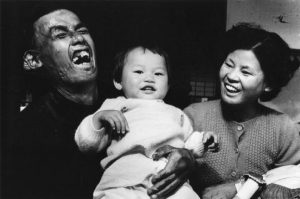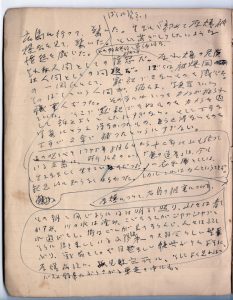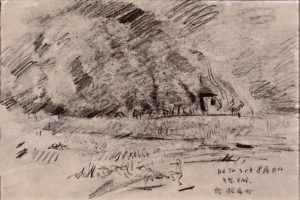Special exhibition of preserved memories of A-bombed Hiroshima to begin at Izumi Museum of Art, including photos by Ken Domon, media materials
Jun. 17, 2023
by Ayano Fukuda, Staff Writer
A special exhibition titled Hiroshima no Kioku (in English, ‘Memories of Hiroshima’), for which materials conveying the history of the A-bombed city of Hiroshima were collected from Japan and overseas, will begin at the Hiroshima Izumi Museum of Art, located in the city’s Nishi Ward, on June 17. The exhibition includes paintings depicting scenes of Hiroshima before World War II, overseas newspaper articles printed right after the atomic bombing, and collections of photographs published after the end of war, all communicating the devastation wrought by the atomic bombing. Around 320 displayed items will shed light on the daily lives that were taken from people by the atomic bombing as well as changes in the news coverage of the event.
“The A-bombed city of Hiroshima is still alive today,” wrote photographer Ken Domon (1909–1990) in his photography collection titled Hiroshima, which was published in 1958. Mr. Domon visited Hiroshima for the first time in 1957. Shocked by the scars of the atomic bombing that remained, he passionately recorded A-bomb survivors and their lives. On display at the exhibition are five photographs taken by Mr. Domon that capture a woman undergoing skin graft surgery and children who had been exposed to A-bomb radiation in their mothers’ womb.
The exhibition will also introduce part of a copy of notes left behind by Mr. Domon. This will be the first time a copy of the notes will be shown to the public, besides a previous showing that took place at the Ken Domon Museum of Photography, located in Sakata City in Yamagata Prefecture. “When I went to Hiroshima, I was in complete shock…I felt a sense of anger that made me want to grind my teeth,” and “I always try to maintain an international viewpoint in all the work I do” are some of the notes written by Mr. Domon that provide insight into his extraordinary zeal.
Mr. Domon wrote that “too much is unknown” about the reality of the atomic bombing. Yasutaka Matsuura, 67, chair of a non-profit organization designed to preserve and utilize photographs of Hiroshima, said he formulated the exhibition plan in partnership with the museum based on Mr. Domon’s words. “We aimed to highlight aspects of the A-bombed Hiroshima that have not thus far been communicated.” The exhibition was also designed to trace the history of press censorship, displaying records of overseas media and publications issued during the Allied occupation by the General Headquarters of the Allied Forces (GHQ).
The U.S. newspaper The New York Times reported on the destructive power of the atomic bombing in its August 7, 1945, issue. On August 31, the newspaper carried a report from Hiroshima, but the article did not mention radiation. Soon, the U.S. government started restricting news coverage of the atomic bombings in the country. Hiroshima, an account written by John Hersey that communicated the voices of A-bomb survivors, was published in August 1946, one year after the atomic bombings. An original copy of The New Yorker magazine, which carried the report, will also be displayed at the exhibition.
The exhibition will also introduce HIROSHIMA, an English photography magazine compiled in Hiroshima in 1949, at a time when Japan was still under Allied occupation. Few copies of the magazine are assumed to exist because most did not make it past the censorship in place at the time to circulate around the city. The magazine, describing for non-Japanese people the role of Hiroshima, then a military city, and the devastation caused by the atomic bombing, featured a series of eight illustrations describing the atomic bombing drawn by Hatsusaburo Yoshida. Mr. Yoshida was proficient at bird’s-eye illustrations and, for that, was known as the Hiroshige of the Taisho Era (1912–1926), after a renowned woodblock ukiyo-e artist from the Edo period (1603–1867).
Other artwork representing the A-bombed Hiroshima at the exhibition includes copies of a series of illustrations by the painter Goro Shikoku that depict the cityscapes of Hiroshima before World War II, as well as sketches drawn by the artist Yoshiro Fukui capturing scenes of Hiroshima right after the atomic bombing.
The exhibition will be held through August 27. The museum is closed on Mondays, except July 17, when its doors will remain open. The exhibition is sponsored by the Chugoku Shimbun and the museum.
(Originally published on June 17, 2023)
A special exhibition titled Hiroshima no Kioku (in English, ‘Memories of Hiroshima’), for which materials conveying the history of the A-bombed city of Hiroshima were collected from Japan and overseas, will begin at the Hiroshima Izumi Museum of Art, located in the city’s Nishi Ward, on June 17. The exhibition includes paintings depicting scenes of Hiroshima before World War II, overseas newspaper articles printed right after the atomic bombing, and collections of photographs published after the end of war, all communicating the devastation wrought by the atomic bombing. Around 320 displayed items will shed light on the daily lives that were taken from people by the atomic bombing as well as changes in the news coverage of the event.
“The A-bombed city of Hiroshima is still alive today,” wrote photographer Ken Domon (1909–1990) in his photography collection titled Hiroshima, which was published in 1958. Mr. Domon visited Hiroshima for the first time in 1957. Shocked by the scars of the atomic bombing that remained, he passionately recorded A-bomb survivors and their lives. On display at the exhibition are five photographs taken by Mr. Domon that capture a woman undergoing skin graft surgery and children who had been exposed to A-bomb radiation in their mothers’ womb.
The exhibition will also introduce part of a copy of notes left behind by Mr. Domon. This will be the first time a copy of the notes will be shown to the public, besides a previous showing that took place at the Ken Domon Museum of Photography, located in Sakata City in Yamagata Prefecture. “When I went to Hiroshima, I was in complete shock…I felt a sense of anger that made me want to grind my teeth,” and “I always try to maintain an international viewpoint in all the work I do” are some of the notes written by Mr. Domon that provide insight into his extraordinary zeal.
Mr. Domon wrote that “too much is unknown” about the reality of the atomic bombing. Yasutaka Matsuura, 67, chair of a non-profit organization designed to preserve and utilize photographs of Hiroshima, said he formulated the exhibition plan in partnership with the museum based on Mr. Domon’s words. “We aimed to highlight aspects of the A-bombed Hiroshima that have not thus far been communicated.” The exhibition was also designed to trace the history of press censorship, displaying records of overseas media and publications issued during the Allied occupation by the General Headquarters of the Allied Forces (GHQ).
The U.S. newspaper The New York Times reported on the destructive power of the atomic bombing in its August 7, 1945, issue. On August 31, the newspaper carried a report from Hiroshima, but the article did not mention radiation. Soon, the U.S. government started restricting news coverage of the atomic bombings in the country. Hiroshima, an account written by John Hersey that communicated the voices of A-bomb survivors, was published in August 1946, one year after the atomic bombings. An original copy of The New Yorker magazine, which carried the report, will also be displayed at the exhibition.
The exhibition will also introduce HIROSHIMA, an English photography magazine compiled in Hiroshima in 1949, at a time when Japan was still under Allied occupation. Few copies of the magazine are assumed to exist because most did not make it past the censorship in place at the time to circulate around the city. The magazine, describing for non-Japanese people the role of Hiroshima, then a military city, and the devastation caused by the atomic bombing, featured a series of eight illustrations describing the atomic bombing drawn by Hatsusaburo Yoshida. Mr. Yoshida was proficient at bird’s-eye illustrations and, for that, was known as the Hiroshige of the Taisho Era (1912–1926), after a renowned woodblock ukiyo-e artist from the Edo period (1603–1867).
Other artwork representing the A-bombed Hiroshima at the exhibition includes copies of a series of illustrations by the painter Goro Shikoku that depict the cityscapes of Hiroshima before World War II, as well as sketches drawn by the artist Yoshiro Fukui capturing scenes of Hiroshima right after the atomic bombing.
The exhibition will be held through August 27. The museum is closed on Mondays, except July 17, when its doors will remain open. The exhibition is sponsored by the Chugoku Shimbun and the museum.
(Originally published on June 17, 2023)










